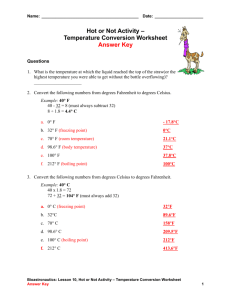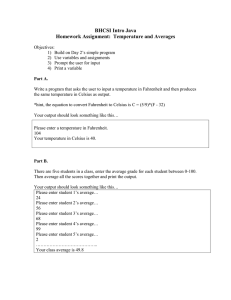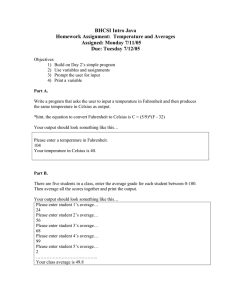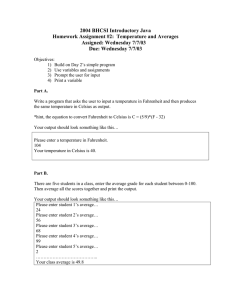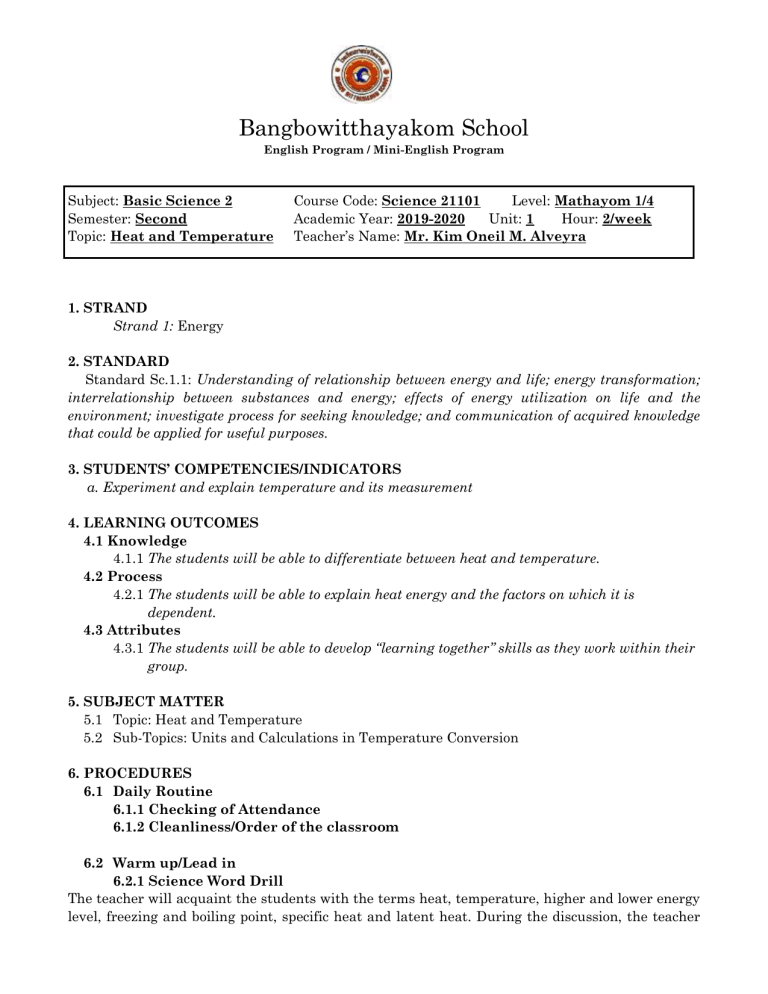
Bangbowitthayakom School English Program / Mini-English Program Subject: Basic Science 2 Semester: Second Topic: Heat and Temperature Course Code: Science 21101 Level: Mathayom 1/4 Academic Year: 2019-2020 Unit: 1 Hour: 2/week Teacher’s Name: Mr. Kim Oneil M. Alveyra 1. STRAND Strand 1: Energy 2. STANDARD Standard Sc.1.1: Understanding of relationship between energy and life; energy transformation; interrelationship between substances and energy; effects of energy utilization on life and the environment; investigate process for seeking knowledge; and communication of acquired knowledge that could be applied for useful purposes. 3. STUDENTS’ COMPETENCIES/INDICATORS a. Experiment and explain temperature and its measurement 4. LEARNING OUTCOMES 4.1 Knowledge 4.1.1 The students will be able to differentiate between heat and temperature. 4.2 Process 4.2.1 The students will be able to explain heat energy and the factors on which it is dependent. 4.3 Attributes 4.3.1 The students will be able to develop “learning together” skills as they work within their group. 5. SUBJECT MATTER 5.1 Topic: Heat and Temperature 5.2 Sub-Topics: Units and Calculations in Temperature Conversion 6. PROCEDURES 6.1 Daily Routine 6.1.1 Checking of Attendance 6.1.2 Cleanliness/Order of the classroom 6.2 Warm up/Lead in 6.2.1 Science Word Drill The teacher will acquaint the students with the terms heat, temperature, higher and lower energy level, freezing and boiling point, specific heat and latent heat. During the discussion, the teacher will revisit the terms from time to time to increase the retention through repetitive practice. And during oral recitation, the students must be able to use as much words in their answer from the word wall (wall that contains all the vocabulary that was learned from the old topics to the current one). 6.2.2 Motivation The teacher will ask the students random questions like “Raise your hand if you ever put on a jacket? Or turned on a heater? Or melted an ice cube in your hand?”. And from the answers of the students, the teacher will introduce the terms heat and temperature. 6.2.3 Review The teacher will ask the class about energy, since it’s a common term in science. From there, the teacher will start introducing heat as a form of energy. 6.4 Presentation 6.3.1 Discussion The teacher will have a discussion for 15 minutes about the concept of heat and temperature, its units and calculations. It shall answer the following questions: 1. What is heat? 2. What is temperature? 3. What is the difference between heat and temperature? 4. How is temperature measured? 5. What are the units of temperature? 6. What are the conversion factors of the units of temperature? 7. What is latent heat? (includes formula) 8. What is specific heat? (includes formula) 9. What is the difference between latent heat and specific heat? 6.3.2 Group Activity The students will be provided with worksheets that they must complete with their group. The questions in the worksheets range from essay writing, solving, labeling the diagram, and fill in the blanks. 6.3.3 Conclusion/Generalization Heat is the flow of thermal energy from one medium to another, or from an energy source to an object. Temperature is the measure of the average kinetic energy of an object. In its simplest definition, it measures the hotness or coldness of an object. While these two terms are often used interchangeably, they are different in such a way that heat is the transfer of energy from a high temperature to a low temperature, while temperature is the measure of the average motion of the molecules. The most common unit for temperature is the degree Celsius, and we also have other units like degree Fahrenheit, Kelvin, and Romer. These unit can be converted into each other given its conversion factors. Other terms related to the concept of heat and temperature are latent heat and specific heat with formulas Q=mL and Q-mc(tf-ti). 7. EVALUATION 7.1 Question and Answer Drill (Recitation) To check understanding of the students, the teacher prepares questions during checkpoints (check for understanding) ranging from lower order thinking skills to higher order thinking skills questions and picks random number of students to answer. Category Organization Content Rubrics for Graded Recitation Indicators The idea is presented in a logical and comprehensive sequence. The vocabularies are well-defined in a context comprehensive to the audience. Includes the most essential answer to the question. Develops summary that is relevant to the question. Score 2 2 3 3 The student’s individual understanding will also be measured by an individual seat work especially on solving. 7.2 Student Worksheet The students will be provided with worksheets that they must complete with their group. The questions in the worksheets range from essay writing, solving, labeling the diagram, and fill in the blanks. 7.3 Vocabulary The following terms will be used in the lesson: Heat – A form of energy that is being transferred between objects Temperature – the measure of the average kinetic energy of an object Kinetic energy – energy in motion Latent Heat – the heat required to convert a solid into a liquid, or a liquid into a vapor, without change of temperature Specific Heat – the heat required to raise the temperature of the unit mass of a given substance by a given amount (usually 1 degree) Flow of energy – from higher temperature to lower temperature 7.4 Homework The students need to answer the questions in their workbook (1B), pages 24-25. 8. MATERIALS 8.1 Powerpoint presentation 8.2 Worksheet 8.3 Workbook Prepared By: Mr. Kim Oneil M. Alveyra Subject Teacher Checked By: Ms. Thanyawadee Phanomkhet Head, E.P./M.E.P. Prgram Worksheet #1 Title: Heat and Temperature Group Number: _____ Date: _______________ Members (Nickname and Number): _________________________________ _________________________________ _________________________________ Score: ________ ________________________________ ________________________________ I. Definition 1. Define what is heat: _____________________________________________________________________________________ ___________________________________________________________________________________________ ___________________________________________________________________________________________ ___________________________________________________________________________________________ 2. Define what is temperature: _____________________________________________________________________________________ ___________________________________________________________________________________________ ___________________________________________________________________________________________ ___________________________________________________________________________________________ 3. Define what is the difference between heat and temperature: _____________________________________________________________________________________ ___________________________________________________________________________________________ ___________________________________________________________________________________________ ___________________________________________________________________________________________ II. Fill in the missing value Unit Celsius Fahrenheit Freezing Point 0o Boiling Point 212o 273 Romer 60o III. Unit Conversion (Show your solutions) 1. Convert 30oC to Fahrenheit 2. Convert 113oF to Celsius 3. Convert 573K to Celsius 4. Convert 60oR to Fahrenheit

